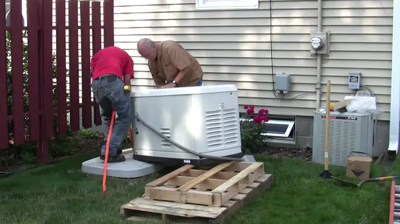
Power outages can be stressful, especially when they last for hours or days. Homeowners increasingly rely on standby generators to ensure uninterrupted power for critical appliances and systems. These permanently installed units automatically restore electricity when the grid fails, offering convenience and peace of mind.
However, many people wonder whether installing one can be a do-it-yourself project. While home generators are valuable for maintaining energy independence, installing a standby model involves complex electrical, mechanical, and safety requirements that typically demand professional expertise.
What Are Standby Generators?
A standby generator differs significantly from a portable unit. Instead of being plugged in manually, a standby generator connects directly to a home’s electrical system and activates automatically during an outage. It runs on natural gas, propane, or diesel, depending on the home and generator’s setup, and can power the entire property or essential circuits.
Because it integrates with existing wiring, fuel systems, and the home’s main electrical panel, this type of generator is more complex to install. It also requires an automatic transfer switch that detects power loss and signals the generator to start. Understanding how all these parts interact is essential before considering any installation work.
How Complicated Is Home Generator Installation?
Installing a standby generator involves several technical steps that extend beyond basic home improvement skills. It requires connecting high-voltage wiring, integrating a transfer switch, and ensuring proper fuel delivery. Any errors in these processes can pose serious safety risks, including electrical shock, gas leaks, or fire hazards.
In addition to technical difficulty, precision is critical. The system must be correctly sized to meet the home’s energy needs, with load calculations guaranteeing that appliances receive adequate power without overloading circuits. Even small miscalculations can lead to generator failure or damage to the home’s electrical infrastructure.
The installation also involves managing multiple utility connections (such as gas lines, fuel tanks, and electrical wiring), all of which must meet local safety codes. This combination of tasks makes professional installation the most reliable option for long-term performance and safety.
Regulations and Safety Considerations
Electrical and building codes regulate the installation of standby generators to prevent hazards. Most municipalities require permits, inspections, and compliance with the National Electrical Code (NEC). Attempting to bypass these requirements can lead to fines, insurance issues, or unsafe conditions.
One critical safety component is the transfer switch, which isolates the home’s circuits from the main utility grid. Without it, the generator could feed power back into utility lines, a phenomenon known as backfeeding, which endangers utility workers and damages electrical systems. Proper grounding, ventilation, and clearance are also necessary to prevent overheating and carbon monoxide buildup.
Fuel connections add another layer of complexity. Natural gas and propane systems must be pressure-tested and leak-checked before activation. Improper connections or undersized lines can prevent the generator from operating correctly or create dangerous conditions. Licensed professionals understand these requirements and can promise compliance with safety standards from the start.
Why Hiring a Professional Is Recommended
While you can choose to install your generator yourself, it’s not recommended and comes with sizable risks and limitations. These include handling your own product registration and often not being eligible for extended warranties. Additionally, for some companies, the generator’s warranty start date will default to the factory ship date or purchase date, and any failures due to improper installation will not be covered under warranty.
A licensed electrician or certified generator installer has the tools and training to perform each step safely and efficiently. Professionals handle the entire process (site evaluation, permitting, installation, and testing) so the generator functions seamlessly when needed. They also verify that the system meets manufacturer specifications, which is often a condition for maintaining the product warranty.
Professional installers make sure the generator’s electrical output is properly balanced with the home’s load demands. They also verify automatic startup sequences, inspect fuel lines, and integrate monitoring systems for maintenance alerts. This attention to detail guarantees reliable performance and provides peace of mind knowing the installation meets all legal and safety requirements.
Costs and Long-Term Value
While professional installation increases initial costs, it delivers long-term benefits. A properly installed standby generator can operate efficiently for years with minimal maintenance. In contrast, a poorly executed DIY project may lead to expensive repairs, shorter lifespan, or even voided warranties.
Investing in expert installation also adds property value. Buyers often view professionally installed standby systems as premium home features, particularly in regions prone to severe weather or unreliable power grids. Over time, the assurance of reliable backup power outweighs the upfront expense.
Additionally, trained technicians can recommend the optimal generator size and fuel type for the home’s energy profile. This guidance helps homeowners avoid overspending on oversized systems or underestimating power requirements, both of which affect long-term efficiency.
Powering Up the Right Way
Installing a standby generator may appear manageable, but the complexity of electrical and fuel systems makes it a task best left to professionals. Proper installation ensures compliance with safety codes, preserves manufacturer warranties, and guarantees the generator performs reliably during emergencies.
A professional approach protects the investment and safeguards the home and everyone inside it. When it comes to dependable backup power, doing it the right way means doing it safely, and that starts with expert installation.


(0) comments
We welcome your comments
Log In
Post a comment as Guest
Keep it Clean. Please avoid obscene, vulgar, lewd, racist or sexually-oriented language.
PLEASE TURN OFF YOUR CAPS LOCK.
Don't Threaten. Threats of harming another person will not be tolerated.
Be Truthful. Don't knowingly lie about anyone or anything.
Be Nice. No racism, sexism or any sort of -ism that is degrading to another person.
Be Proactive. Use the 'Report' link on each comment to let us know of abusive posts.
Share with Us. We'd love to hear eyewitness accounts, the history behind an article.